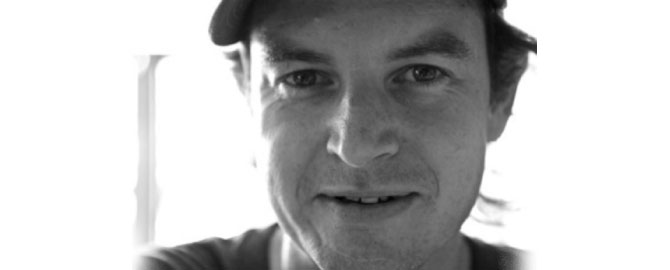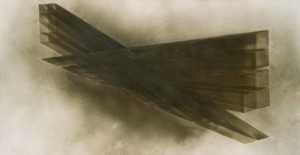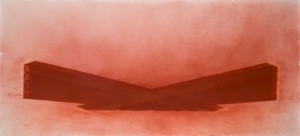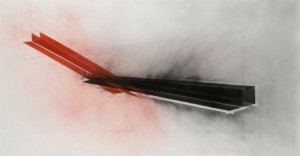South African artist Sean Slemon, now lives and works in Brooklyn, NY. He is a sculptor who uses a range of materials, techniques and disciplines. Slemon’s pieces, whether 2D or 3D, use simple mostly natural materials in an unconventional and resourceful manner. This might be a by-product of his unusual and somewhat quirky upbringing, in a time and a place that was notorious for its political and controversial history. His clean and linier works sit juxtaposed and in defiance to the glutinous consumerism of Western culture.
Slemon confronts social equality and injustice; other works engage the fateful disaster of Hurricane Katrina and the controversial political consequences. He is an artist who uses Art to challenge, forcing us, when faced, into uncomfortable corners.
In 2005 Slemon was a joint winner of South Africa’s Sasol New Signatures Competition, and was presented with the Judges Award. In the past he has been awarded a commission for the first Spier Biennial and served on the committee for Visual Arts Network of South Africa. Slemon has worked on ‘The New Northern Cape Legislature Buildings’ in Kimberley, Constitutional Hill Museum, Johannesburg, and ‘46664 A Prisoner Working in the Garden’, Nelson Mandela Foundation traveling exhibition. In 2007 he attended the Skowhegan School of Painting and Sculpture residency and received a Chashama Studio residency in the same year.
In his own words
Could you please introduce yourself and tell us a bit about your background and how you became an artist?
Hi – my name is Sean Slemon. I was born in Cape Town, South Africa in 1978. I am the youngest of four children to Irish parents from Dublin who emigrated to South Africa in 1976. My father was a theatre director and he obtained a job at the Baxter Theatre and so moved the family to SA – an unusual move, for at the time most whites were leaving South Africa for London and Europe. My mother was a potter and I spent a lot of time with her in the studio making things out of clay and just playing around. All through school I took art as a subject and by the time I reached High School I was lucky enough to have a young energetic teacher who was encouraging. After school I decided to travel abroad – to the UK and Ireland, where I have extended family. After two years, I returned to South Africa to study and applied to the University of Cape Town. I completed my BA in Fine Art there in 2000, majoring in sculpture. In 2001 I won my first public commission. For the next 4/5 years I worked on various public sculpture projects for other artists, and by 2005 I was able to set up my own studio and enter into a more consistent studio practice. I had my first solo show in Johannesburg in 2005, and I have been working consistently as an artist since this time, amongst other things too
Your work is conceptual, challenging the viewer. Describe the steps involved in creating your works. How do you develop your ideas, through to resolved finished images?
Executing some of my ideas can be very labour intensive and time consuming- especially with the larger works. I feel though that my works and ideas have been developing and building on themselves in a similar vein since around 2005/6. The basis of these ideas came out of a desire to explore equality -something that in South Africa was and still is a very pertinent issue. I have chosen to extract simple but striking images related to this issue and the ideas around it. Things like the tree, light and the shadow are things that became “objects” for me. I usually begin by choosing an image – drawings, in the form of pencil, and later and more recently I have been doing drawings in soil. I also have always done etchings, and I use these as an opportunity to work out larger ideas. When it comes to sculpture, I’ll draw the idea over and over, just to allow myself to think about it – not to create a drawing in itself. When it actually comes to making a work I have usually spent a lot of time thinking it through – making sure the fabrication process is clear and workable. I often lie awake at night or early in the morning processing and mulling over various issues, so by the time I get to the studio to make a work I have a clear idea of how to proceed. As the making itself proceeds this generally opens the tap for other ideas and I generally get more works going alongside. Starting the first piece is always the hardest, so I often choose to make something that leaves off from the last body of work. It’s best to begin in a comfort zone and slowly move yourself out of that.
Which contemporaries would you list amongst your personal favourites’ and why?
I will have to give you two lists here: South Africa. Cameron Platter – produces sculpture and painting which examines the gaps in South Africa’s desire for a quick fix – using satire and cynicism. Zen Marie – a conceptual video artist, who examines the political situation in the country. Wim Botha is also someone I have huge respect for – produces extremely well made and clearly thought out sculpture, installation and drawing. Pieter Hugo – a photographer who looks at unusual sides of African scenes and situations that we normally don’t see.
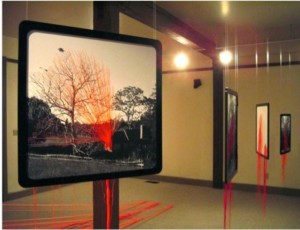
The ambiguous relationship between man and nature. Tree and House, Tree and Barn, Tree and Fence, Tree and Shadow. Archival digital prints, cotton thread, acrylic frames, 20” X 30” / 50cm X 76cm 2007
In the United States: Alexandre Arrechea – I love his drawings – and they are a great way of exploring larger sculptural works. Amanda Mathis – has begun to cut up buildings and take them apart in a new fashion – a site-specific examination that has endless opportunity in a city like New York. Nathaniel Stern – his etchings are great, and his ability to work consistently and produce while teaching is admirable.
You are South African, now you are living in the US. Do you think that this effects your work? Does the South African perspective differ from the American perspective in regards to the Art world? If so how?
Yes it does affect my work. Whether or not it is a positive or negative thing I am unable to say. I have often wondered where my work would be now, if I had not come to the US. I still feel very much that the basis of my ideas and concepts are rooted in my South African upbringing and experience. Maintaining a connection to my home country is extremely important to me, and I make a point of going back and doing a show or project there about once a year – be it a solo show, or just a work on a group exhibition, residency or print project. It does affect my work of course. I have different materials and resources here and living in a city like New York it is hard to be unaffected by the many images that surround us. I also feel that my aesthetic has changed – it has become cleaner, simpler and clearer and trimmed down – maybe even more spare. This is possibly a product of living in such a busy place.
It’s important to note that the South African perspective on art, studies and the art world is more informed and takes it’s lead from that of Europe and the U.K.
I was so surprised when I first came to the US with how concerned and enamoured people and artists were with modern practices of abstract expressionism and the like. The US is a very insular and closed off art world and the more I see of it the more I feel I should just stick to my studio. I don’t appreciate the rampant consumerism and commoditization. This is something that my work also deals with: taking the intangible, assigning value and assuming ownership.
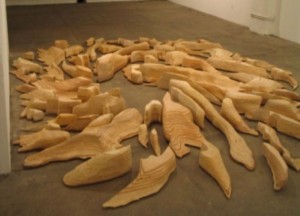
A scaled sculpture of Hurricane Katrina, in which the sculpture is made from plywood that has been disposed of. The conceptual motivation was to fabricate a hurricane out of a material from which it would have directly destroyed during the hurricane. Each section of the work replicates a singular cloud formation, making up the entire mass of the storm. Hurricane Katrina Plywood, Installation at David Krut New York, USA, 2006
Artists like to push boundaries, challenging the viewers attitude and personal perspective of the world around us. Why is the artist in an unusual and special position to make statements that make us think about issues that many wouldn’t do ordinarily?
I think the art world is at in interesting point right now, between the consistent image of a painting, drawing or sculpture, and the need for social practice, or work that has an effect or function beyond that of just the aesthetic. I think that society has reached a point where just a beautiful object alone is not enough. People desire meaning and function from artwork – be that conceptual or other. I think another challenge of the art world is accessibility: for both artists as well as museums, galleries and the like. I feel art has become so wrapped up in ego and status now, that much has been lost in this evolution. Artists have an opportunity to bring work back to its roots and to begin really asking questions in more meaningful ways. Gone are the days when someone was offended by an artwork: I’m not abdicating for more offensive work, but for work that has the power to change things that are wrong with society, making more clear the levels of inequality that still exist for no reason other than greed and lack of access.
How has your work grown and progressed in the past decade?
I feel that over the last ten years I have streamlined my ideas, trimmed them down, and begun to make them more concise. I think that I am also less concerned with the conceptual basis that I had held so dearly close to my work before. I made a conscious decision to put this aside and the interesting thing is that work grows out of this without it being forced out of, or from a specific idea. This was a great discovery for me because it meant that I was on the right road in terms of what I was making – these ideas are going to be processed and manifest regardless. Most importantly it has allowed me to have a lot more fun with the work. I have also become a much better builder and sculptor, and this has allowed me to come closer to realizing the object I want to make, expanding my capabilities and language of making. This gives one confidence and I feel is extremely important. I am very connected to my studio and have a very traditional studio practice, I suppose.
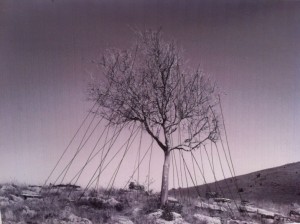
A page from Slemon's sketchbook. "Here is a shot from my sketchbook from a project I did in South Africa last year in May/June. I was on a residency at the Nirox Foundation, just outside Johannesburg I did this image- a photograph, printed on copy paper, with ink lines drawn over the image. This image ended up being used for an etching, as well as a site specific installation out in the bush, on the same tree".
What future plans do you have? What projects would you like to accomplish?
Right now I am in the process of compiling a proposal for a public site-specific installation. This of course may or may not come through, but it is always nice to have the opportunity to make new ideas and think on a grander scale that has been a goal of mine for some time. I am currently also planning a solo exhibition to be held in Cape Town, South Africa, later this year or early next year. Next year I plan to hold a solo show with my US gallery MagnanMetz as well.
In the meantime I am working on our newest addition – our adopted baby daughter who is just 8 weeks old. She takes up a lot of time, but we love her.
Sean Slemon (born 1978, Cape Town, Republic of South Africa) is a South African artist who works in sculpture, installation and printmaking. In 2001 Slemon graduated from Michaelis School of Art in Cape and completed his MFA degree at Pratt Institute, Brooklyn, in New York City in 2007. He lives and works in New York City, USA. Slemon regularly exhibits in the US and South Africa.
All images courtesy of Sean Slemon | www.seanslemon.com
For more information on Hong Kong Art Tutoring please contact:
Gail Deayton
Telephone: +852 9722 8353
Email: gd@gaildeayton.com

